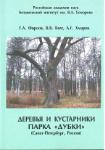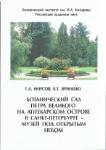Текст
АКАДЕМИЯ НАУК СССР
БОТАНИЧЕСКИЙ
ACADEMY OF SCIENCES OF THE USSR
V. L. KOMAROV BOTANICAL INSTITUTE
BOTANICAL
,GARDENS^
TEXT BY J. LUKS AND V. SOLODOVNIKOVA
PHOTOS BY E.SINELNIKOV
EDITED BY
PROF, s . SOKOLOV
PUBLISHING HOUSE OF USSR ACADEMY OF SCIENCES
MOSCOW - LENINGRAD
1 9 5 9
АКАДЕМИЯ НАУК СССР
БОТАНИЧЕСКИЙ ИНСТИТУТ им. В . Л.КОМАРОВА
БОТАНИЧЕСКИЙ
ТЕКСТ Ю. А.ЛУКСА и В.С.СОЛОДОВНИКОВОЙ
ФОТОГРАФИИ Е.В.СИНЕЛЬНИКОВА
ПОД РЕДАКЦИЕЙ
ПРОФ. С. Я СОКОЛОВА
ИЗДАТЕЛЬСТВО АКАДЕМИИ НАУК СССР
МОСКВА -ЛЕНИН ГРАД
<959
Сады и парки Ленинграда — одно из лучших украшений города.
Парк Ботанического института имени В. Л. Комарова Академии
наук СССР, более известный как Ботанический сад, ведет свое начало
от Аптекарского огорода, заложенного в 1714 году по приказу Петра I.
Уже в Аптекарском огороде, кроме изучения лекарственных расте-
ний, велась интродукция деревьев, кустарников и травянистых рас-
тений.
В первой половине XIX века восточная часть бывшего Аптекарского
огорода, расположенная вдоль набережной реки Большой Невки, была
превращена в парк, разбитый в регулярном стиле. До настоящего вре-
мени эта часть Парка осталась без изменений; в ней растут старые де-
ревья посадки двадцатых годов XIX века.
К началу текущего столетия Парк принял вид, который он имеет
теперь, причем большая его часть спланирована в пейзажном стиле.
В 1931 году Ботанический сад был объединен с Ботаническим му-
зеем в Ботанический институт Академии наук СССР.
Парк и питомники Ботанического сада служат экспериментальной
базой по интродукции и акклиматизации новых полезных растений.
Ботанический сад ввел в культуру в Петербурге—Ленинграде сотни
видов декоративных растений, а также многие виды лекарственных,
плодовых, технических и других полезных растений и распространил их
по всей стране.
Ботанический сад ведет постоянный обмен семенами со всеми бота-
ническими садами мира.
Парк Ботанического сада является любимым местом отдыха ленин-
градцев, приезжих из других городов и республик Советского Союза,
а также многочисленных зарубежных гостей и туристов. Ежегодно его
посещают около 200000 человек. Кроме того, в нем проводятся много-
численные учебные экскурсии.
Чтобы иметь представление о красоте Парка Ботанического сада
надо видеть его во все времена года.
The parks and gardens of Leningrad constitute one of its best decora-
tions.
The Botanical Gardens of the Komarov Botanical Institute of the Aca-
demy of Sciences of the USSR — originated as the „Aptekarskii ogorod“
(a sort of a nursery for officinal plants) was established in 1714 on the
order of Peter the 1st.
Even at the time of its foundation the introduction of trees, shrubs
and herbaceous plants was carried on in addition to officinal plant inve-
stigation.
In the first half of the 19th century, the eastern part of the former
„Aptekarskii ogorod“, situated along the bank of the Bolshaja Nevka,
was transformed into a Park laid out in the regular style. Up to the pre-
sent time this part of the Park remains unchanged. The old trees planted
in the twenties of the 19th century are still to be found here.
By the beginning of our century the Park has assumed its present
aspect, the greater part of it being laid out in the landscape style.
In 1931 the Botanical Gardens together with the Botanical Museum
became the Botanical Institute of the Academy of Sciences of the USSR.
The Park and the nursery gardens serve as an experimental base for
the introduction and acclimatization of new useful plants. This gave an
opportunity to introduce in Peterburg—Leningrad hundreds of decorative
species and to propagate these species as well as many species of offici-
nal, fruit, technical and other useful plants all over the Soviet Union.
The Botanical Gardens carries on a continuous exchange with all Bota-
nical gardens of the world.
Our Botanical Gardens is a favourite place of rest for the citizens of
Leningrad and guests from other cities and republics of the USSR as
well, the number of visitors being 200000 annually. Besides it is visited
by numerous educational excursions.
In order to get an idea of the beauty of our Botanical Gardens it is
necessary to see it in al) the seasons.
Ботанический институт имени В. Л. Комарова Академии наук СССР. Здание гербария и библиотеки.
A view of the Komarov Botanical Institute of the Academy of Science of the USSR. Herbarium and Library.
В конце марта на проталинах зацветают первые весенние цветы — подснежники (Gaianthus
caucasicus (Bak.) A. Grossh.). Вскоре они в полном цвету.
At the end of March the first spring flowers Galanthus caucasicus (Bak.) A. Grossh. appear
on the thawed patches of earth.
di
В апреле в Парке уже много цветущих растений и среди них белоцветник весенний
(Leucojum vernum L.).
In April there are already a great many flowering plants in the Park and Leucojum
ver num L. among them.
На ярком весеннем солнце горят белые, желтые и светло-сиреневые цветки крокусов
(Crocus hybridus hort.).
In the bright spring sun gleam white, yellow and pale-lilac Crocus hybridus hort.
Из деревьев первой зацветает ольха серая (Alnus iпсапа (L.) Moench).
Alnus incana (L.) Moench is the first to bloom among the trees.
Буйно цветет черемуха (Padus racemosn (Lam.) Gilib.). Весна на
исходе.
Padus racemosa (Lam.) Gilib. full bloom. Spring is comming
to an end.
Шаровидные и конические формы туи западной (Thuja accident al is L.) очень хороши при
посадке вдоль дорожек и аллей.
Spherical and conical forms of Thuja occidentalis L. fit for planting along the garden-walks
and alleys.
Колючие голубые ели (Picea pungens Engelm. f. glauca Beissn.) выделяются своей изящной
конусовидной кроной и красивой голубовато-серебристой хвоей. Среди хвойных эти ели
наиболее стойки в городских условиях.
Picea pungens Engelm. f. glauca Beissn. remarkable for their fine conical crown and beautiful
bluish-silvery needles. These are the most resistent among the conifers under urban conditions.
‘‘Шй
ИИГ VI
Мак восточный (Papaver orientale L.). Конец июня. Лето вступает
в свои права. В Парке роскошно цветут пеоны (Paeonia hybrida
f. flore pl eno hort.).
Papaver orientale L. The end of June. The summer is full swing.
In the Park Paeonia hybrida f. flore pleno hort. are in full bloom.
Июль — середина короткого северного лета! В это время зацветает чубушник (Philadelphus pallidus Нау.). Кусты его
усыпаны белыми или чуть кремовыми душистыми цветками.
July — the middle of a short northern summer. Philadelphus pallidus Hay. begins to flower. It is covered with fragrant
white or creamy flowers.
Кольцо оранжерей с тропическими и субтропическими растениями является основным композицион-
ным центром Ботанического сада. Вокруг оранжерей широко раскинулся Парк. Большая пальмовая
оранжерея (высота 26 м).
The conservatories with tropical and subtropical plants is the main architectural centre of the botanical
gardens, the Park is stretching around them. The great palm conservatory (26 m in height).
Пышная крона серебристого клена (Acer saccharinum L. f. laciniatum (Carr.) Rehd.).
Тонкие, плакучие ветви с пальчато-лопастными, снизу серебристыми листьями ниспадают почти
до самой земли.
The exuberant crown of Acer saccharinum L. f. laciniatum (Carr.) Rehd. Thin, drooping
branches with deeply cut silvery leaves bend low nearly reaching to the very ground.
Необычны и оригинальны ползучие, причудливо искривленные стволы лиственицы (Larix decidua
Mill. f. pendulina Rgl.).
Peculiar and fancifully curved are the stems of Larix decidua Mill. f. pendulina Rgl.
Свободно разбросанные деревья и купы кустов не утомляют глаз. Вода обогащает ландшафт.
Freely dispersed trees and groups of shrubs are restful to the eye, the presence of water diversifying
the landscape.
Ольха серая {Alnus incana L.) Moench
Ива ломкая (Salix fragilis L.).
Горбатый мостик.
Curved bridge.
На горке — разноцветный мак-самосейка (Papaver г hoe cis L.).
Papaver rhoeas L. on a hillock.
В этом старинном здании
начала XIX столетия помещает-
ся отдел геоботаники.
In this old building (of the be-
ginning of the 19th century) is
located the geobotanic section.
Сахалинская гречиха (Polygonum sachalinense F. Schmidt)—гигантское многолетнее травянистое растение. Оно имеет большую
будущность как кормовое и дубильное растение.
Polygonum sachalinense F. Schmidt — a gigantic perennial herbaceous plant. This is very promising as fodder and tanning plant.
Березовая роща.
The birch-grove.
Группа даурских листвениц (Larix dahurica Turcz.).
A group of Larix dahurica Turcz.
В глубине Парка под пологом деревьев летом дружно цветут разнообразные злаки.
In the centre of the Park various herbs grow in the shade of the trees in the summer-time.
Золотая осень.
The golden autumn.
Старая узкая аллея в солнечный осенний день.
An old narrow alley on a sunny autumn day.
Листопад.
Falling leaves.
Парк зимой.
The Park in Winter.
Туи западные {Thuja occidentalis L.) и чубушник широколистный {Philadelphus latifolius
Schrad.) под снегом.
Thuja occidentalis L. and Philadelphus latifolius Schrad. covered with snow.
Пласты снега на стволах липы.
Stems of linden under the snow.
После снежной бури.
After a snow storm.
Иней.
Hoar-frost.
Плакучий ильм (Ulmus scabra Mill. var. pendula Rehd.).
Ulmus scabra Mill. var. pendula Rehd.
Весенние тени.
Spring shadows.
ОПЕЧАТКИ И ИСПРАВЛЕНИЯ
Стра- ница Строка Напечатано Должно быть
8 15 сверху has had
8 11 снизу Peterburg Petersburg
15 Подпись под рис., 2 снизу comming coming
18 Подпись под рис., 2 снизу is full is in full
20 Подпись под рис., 2 снизу plants is the plants are the
21 Подпись под рис., 1 снизу deaply deeply
Ботанический сад
Ю. А. ЛУКС и В. С. СОЛОДОВНИКОВА
БОТАНИЧЕСКИЙ САД.
Утверждено к печати
Ботаническим институтом
им. В. Л. Комарова Академии наук СССР
Редактор издательства В. М. Яковлева
Художник С. Н. Тарасов
Технический редактор А. В. Смирнова
Сдано в набор 10/IV 1958 г. Подписано
к печати 16/11 1959 г. Формат бумаги 84Х
1087ц. Бум. л. 1 »/«. Печ. л. 21/2 — 4.10 усл.
печ. л. Уч.-изд. л. 4.18. Изд. № 662. Тип. зак.
№ 755. М-03041 Тираж 5000.
Цена 6 р.
Ленинградское отделение Издательства
Академии наук СССР
Ленинград, В-164, Менделеевская лин., д. 1
1-я тип. Издательства Академии наук СССР
Ленинград, В-34, 9 линия, д. 12












































